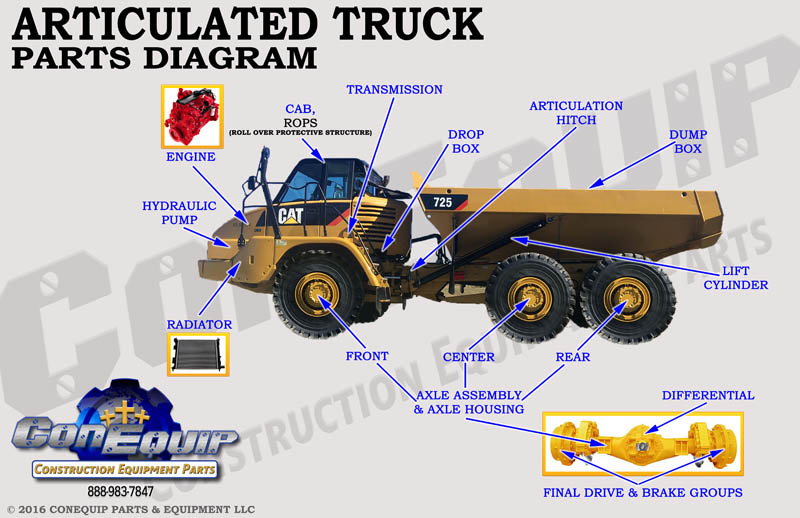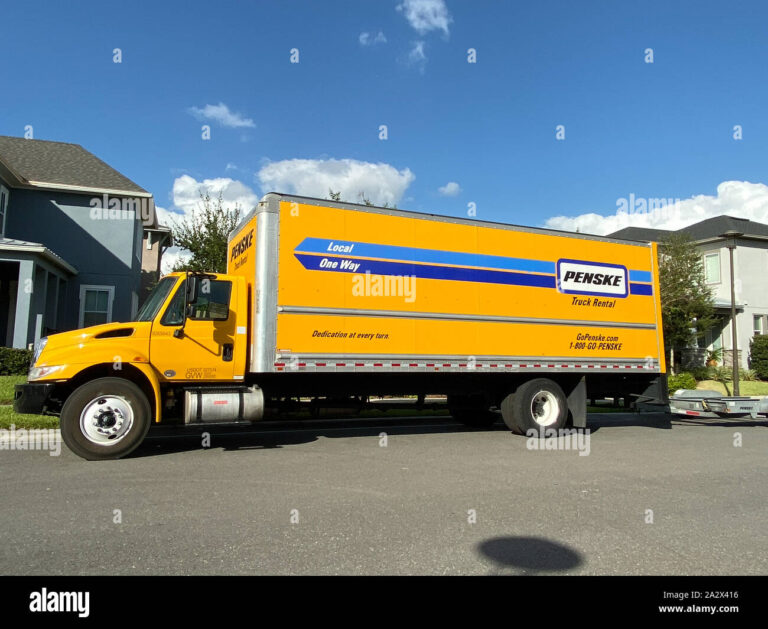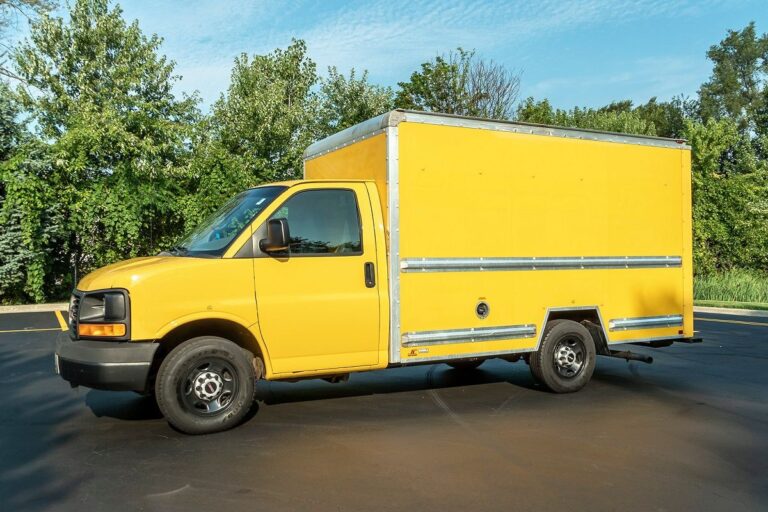Part Of Truck Names: Unveiling the Anatomy of a Road Goliath
Part Of Truck Names: Unveiling the Anatomy of a Road Goliath cars.truckstrend.com
From the rumbling engine to the gleaming chrome, a truck is a marvel of engineering, a complex symphony of thousands of individual components working in unison. Whether it’s a nimble pickup navigating city streets or a colossal semi-truck hauling freight across continents, each part plays a crucial role in its operation, safety, and efficiency. For truck owners, mechanics, enthusiasts, or even curious onlookers, understanding the "Part Of Truck Names" – the specific terminology for each component – is not just about jargon; it’s about empowerment. It enables precise communication, informed maintenance decisions, and a deeper appreciation for these indispensable machines.
This comprehensive guide will delve into the intricate world of truck components, breaking down the vehicle into its primary systems and naming the key parts within each. We’ll explore why knowing these names matters, offer practical advice for identifying them, and address common questions, culminating in a detailed look at the estimated costs associated with various parts.
Part Of Truck Names: Unveiling the Anatomy of a Road Goliath
Why Knowing Your Truck Parts Matters
Before we dissect the truck, let’s understand the importance of this knowledge:
- Effective Communication: When speaking to a mechanic, ordering parts, or explaining an issue, using the correct terminology ensures clarity and reduces misdiagnosis or incorrect part procurement.
- Informed Maintenance and Repair: Understanding what each part does helps you recognize potential problems early, perform basic maintenance, and make educated decisions about repairs.
- Safety: Knowing the function of critical safety components (like brakes, steering, and suspension) helps you assess their condition and contributes to safer driving.
- Cost Savings: Identifying a problem accurately can save you diagnostic fees and prevent costly damage to other components. Buying the right part the first time avoids returns and delays.
- Appreciation and Connection: For enthusiasts, knowing the names and functions of parts deepens their connection to the vehicle and allows for more nuanced discussions about performance and modifications.

The Anatomy of a Truck: Core Components
Let’s begin our journey by exploring the foundational systems that give a truck its structure and power.
1. The Chassis: The Truck’s Backbone
The chassis is essentially the truck’s skeletal structure, providing the framework upon which all other components are mounted.
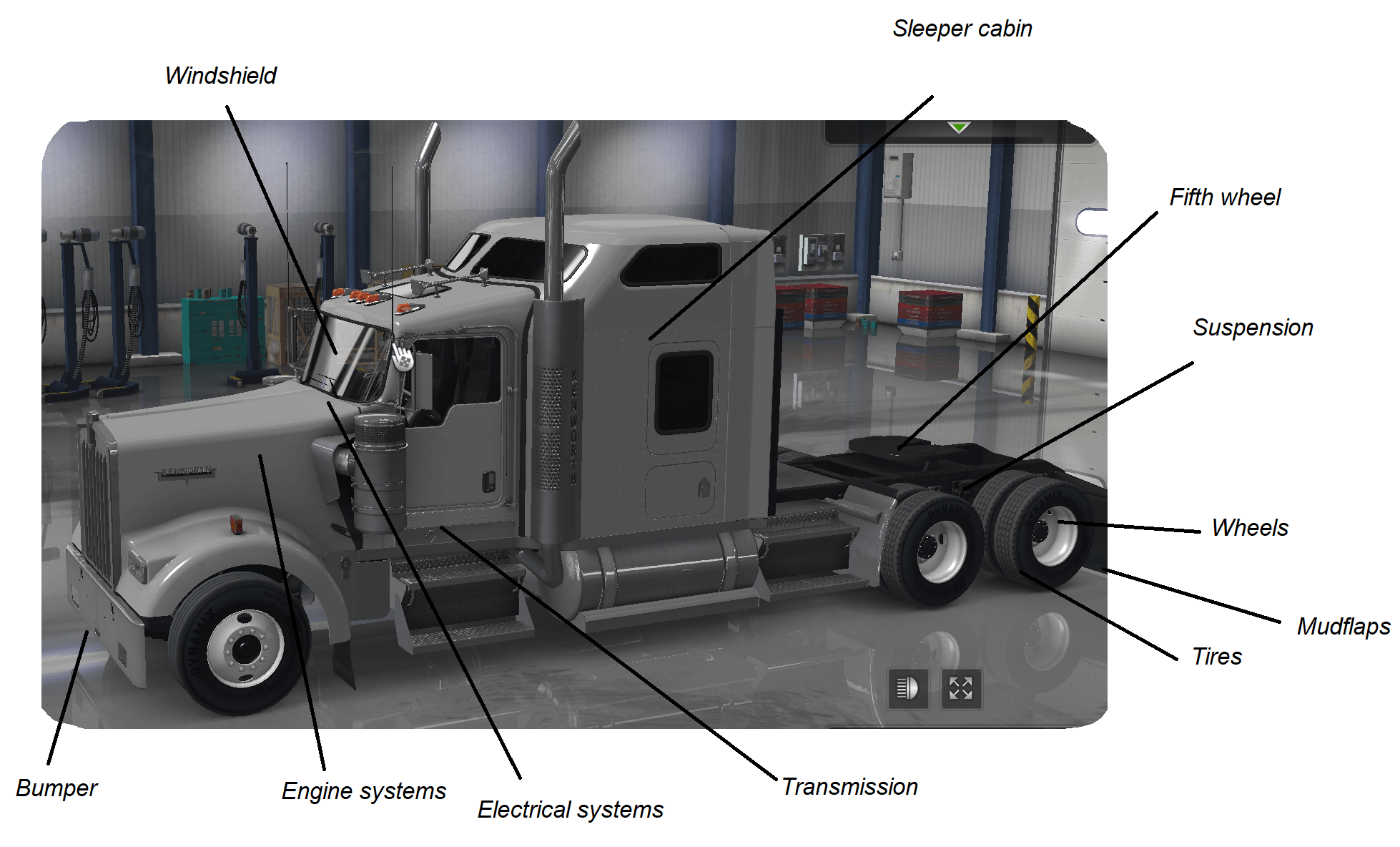
- Frame Rails: The main longitudinal beams that run the length of the truck, forming the core of the chassis.
- Crossmembers: Horizontal beams connecting the frame rails, adding rigidity.
- Suspension System:
- Springs (Leaf Springs, Coil Springs, Air Bags): Absorb shocks and vibrations from the road.
- Shock Absorbers (Dampers): Control spring oscillations for a smoother ride and better handling.
- Axles (Front, Rear, Drive Axles, Tag Axles): Rods connecting wheels, transferring power and supporting weight. Drive axles receive power from the engine.
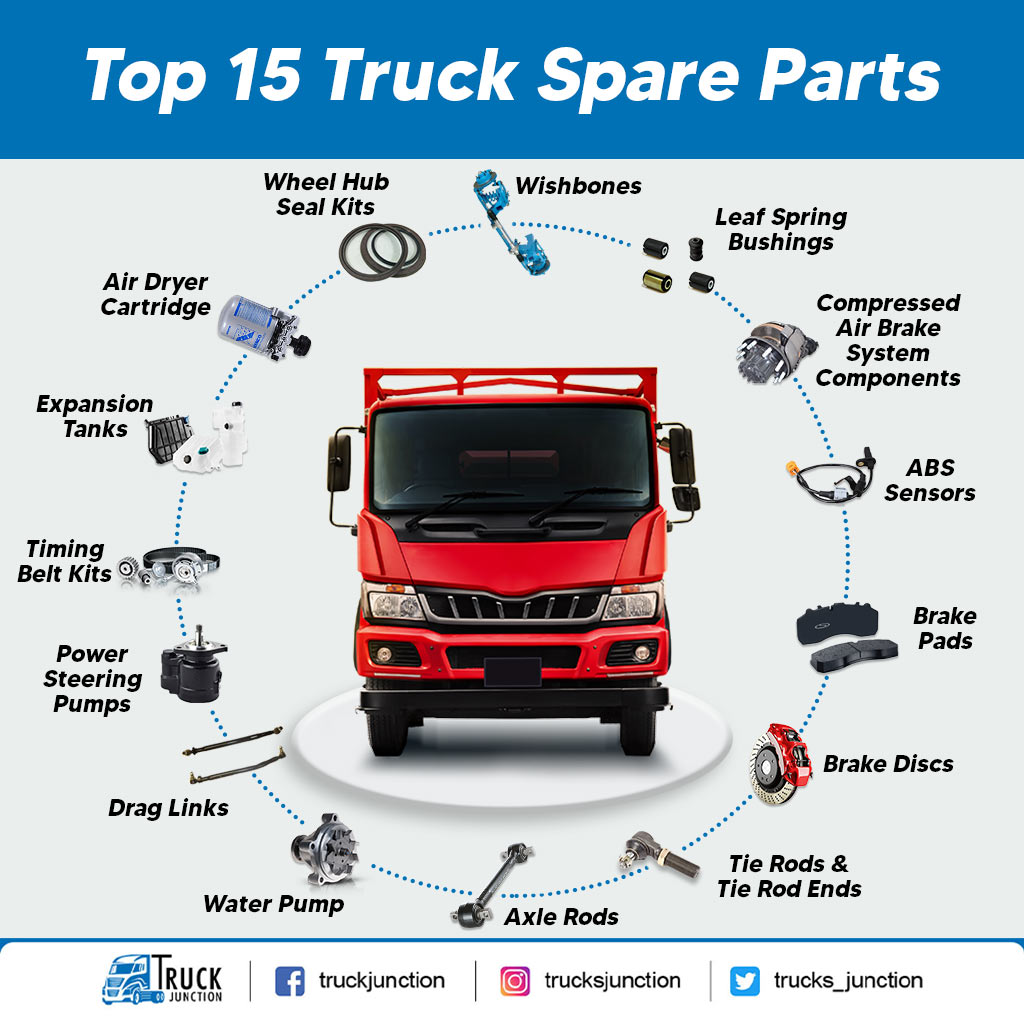
- Wheels & Tires:
- Rims/Wheels: The metal structure to which the tire is mounted.
- Tires: The rubber components that provide traction and cushioning.
2. The Engine: The Heart of the Beast
The engine is the power generator, converting fuel into mechanical energy to move the truck.
- Engine Block: The main structure containing cylinders, where combustion occurs.
- Cylinder Head: Sits atop the engine block, containing valves and often the camshaft.
- Pistons: Move up and down within the cylinders, driven by combustion.
- Crankshaft: Converts the up-and-down motion of the pistons into rotational motion.
- Camshaft: Controls the opening and closing of engine valves.
- Turbocharger/Supercharger (if equipped): Forces more air into the engine for increased power.
- Radiator: Cools the engine by dissipating heat from the coolant.
- Exhaust Manifold & System: Collects exhaust gases from cylinders and routes them through pipes, catalytic converters, and mufflers to exit the vehicle.
3. The Drivetrain: Power to the Pavement
The drivetrain transmits power from the engine to the drive wheels.
- Transmission (Manual or Automatic): Changes gear ratios to match engine speed and vehicle speed, optimizing power and fuel efficiency.
- Clutch (Manual Transmissions): Disengages the engine from the transmission to allow for gear changes.
- Driveshaft (Propeller Shaft): A rotating shaft that transmits power from the transmission to the differential.
- Differential: A gear system that allows wheels on the same axle to rotate at different speeds, crucial for turning.
Exterior Elements: Form and Function
These parts protect the internal components, provide lighting, and contribute to the truck’s aesthetic.
- Bumper (Front & Rear): Impact-absorbing structures at the front and back of the truck.
- Grille: Located at the front, allows air to flow into the radiator for cooling.
- Hood: The cover over the engine compartment.
- Fenders: Panels over the wheels that protect against dirt, water, and debris.
- Doors: Allow entry and exit from the cab.
- Mirrors (Side Mirrors, Convex Mirrors): Provide rear and side visibility.
- Headlights: Front lights for illumination.
- Taillights: Rear lights, including brake lights, running lights, and turn signals.
- Fuel Tanks: Store fuel for the engine.
- Exhaust Pipes/Stacks: Visible parts of the exhaust system, often vertical on heavy-duty trucks.
Interior Features: Comfort and Control
The cab is the driver’s command center and often their home on the road.
- Dashboard/Instrument Panel: Houses gauges (speedometer, tachometer, fuel, temperature), warning lights, and controls.
- Steering Wheel: Controls the direction of the truck.
- Pedals (Accelerator, Brake, Clutch): Control engine speed, braking, and gear changes.
- Seats: Driver and passenger seating. On large trucks, often air-ride seats for comfort.
- Sleeper Cab: An integrated living space behind the main cab in long-haul trucks, including a bed, storage, and sometimes a mini-fridge or microwave.
- HVAC System: Heating, ventilation, and air conditioning controls.
Under the Hood and Beyond: Specialized Systems
Trucks, especially commercial ones, feature advanced systems for safety and operation.
- Braking System (Air Brakes on Commercial Trucks):
- Air Compressor: Generates compressed air for the braking system.
- Air Tanks/Reservoirs: Store compressed air.
- Brake Lines/Hoses: Carry compressed air to brake chambers.
- Brake Chambers: Use air pressure to push the slack adjusters.
- Slack Adjusters: Adjust the distance between the brake shoes and drums/rotors.
- Brake Drums/Rotors: The rotating components that brake shoes/pads press against.
- Brake Shoes/Pads: Friction material that presses against drums/rotors to create braking force.
- Fifth Wheel (for Semi-Trucks): A coupling device mounted on the tractor’s frame that connects to the trailer’s kingpin, allowing the trailer to pivot.
- Kingpin: A vertical pin on the front of the trailer that locks into the fifth wheel.
- Locking Jaws: The mechanism within the fifth wheel that grips the kingpin.
Practical Advice and Actionable Insights
- Consult Your Owner’s Manual: This is your first and best resource for specific part names and functions related to your truck model.
- Utilize Online Resources: Websites, forums, and YouTube channels dedicated to trucks (your specific make/model if possible) are invaluable. Many offer diagrams and video tutorials.
- Visit a Parts Store: Auto or truck parts stores often have exploded diagrams or can show you physical parts, helping you put names to objects.
- Talk to Mechanics: Don’t be afraid to ask your mechanic to point out parts and explain their function during service.
- Start with the Basics: Focus on the major systems first (engine, drivetrain, chassis), then delve into sub-components.
- Learn Common Acronyms: ABS (Anti-lock Braking System), ECM (Engine Control Module), DEF (Diesel Exhaust Fluid), etc.
Challenges in Part Identification
- Brand-Specific Naming: While many parts have universal names, some manufacturers use proprietary terms for certain components or technologies.
- Aftermarket vs. OEM: Original Equipment Manufacturer (OEM) parts are made by the truck’s manufacturer, while aftermarket parts are made by other companies. Names are usually consistent, but slight design variations can exist.
- Regional Jargon: Sometimes, colloquial terms for parts vary by region.
- Evolution of Technology: As trucks become more advanced, new electronic and mechanical components emerge, requiring continuous learning.
Price Guide: Estimated Cost of Common Truck Parts
Please note: The prices listed below are estimated ranges for the part itself, excluding labor, and can vary wildly based on the truck’s make, model, year, condition (new, remanufactured, used), OEM vs. aftermarket, and supplier. This table serves as a general guide to understanding the potential cost scale of various truck components.
| Part Name | Function | Estimated Price Range (Part Only, USD) | Notes |
|---|---|---|---|
| Engine (Remanufactured) | Power generation | $5,000 – $25,000+ | Can be significantly higher for new/specialized engines. Varies by size (pickup vs. semi). |
| Transmission (Remanufactured) | Changes gear ratios | $2,000 – $10,000+ | Automatic transmissions generally more expensive than manual. |
| Differential | Allows wheels to rotate at different speeds | $500 – $3,000+ | Price varies by axle type (front/rear, light-duty/heavy-duty). |
| Turbocharger | Boosts engine power | $500 – $3,000+ | Critical for diesel trucks; replacement can be complex. |
| Radiator | Cools engine coolant | $200 – $1,500 | Material (aluminum vs. copper), size, and complexity affect price. |
| Alternator | Generates electricity for electrical system & battery charging | $150 – $600 | Essential for keeping the battery charged and running electrical components. |
| Starter Motor | Cranks the engine to start it | $100 – $500 | Often a straightforward replacement. |
| Fuel Pump | Delivers fuel from tank to engine | $80 – $400 | Can be in-tank or external; often comes as an assembly. |
| Brake Pads/Linings (Set per Axle) | Creates friction for braking | $50 – $250 | Varies by material (ceramic, metallic) and vehicle weight. |
| Brake Rotors/Drums (Each) | Component that pads/linings press against | $40 – $300 | Rotors for disc brakes, drums for drum brakes. |
| Shock Absorber (Each) | Controls suspension oscillation | $30 – $200 | Can be gas-charged or hydraulic. |
| Leaf Spring (Each) | Suspension component | $100 – $500+ | Price varies by number of leaves and weight rating. |
| Tire (Each) | Provides traction and cushioning | $100 – $600 (Light Duty); $300 – $900+ (Commercial) | Varies significantly by size, type (all-season, off-road), brand, and load rating. |
| Headlight Assembly (Each) | Front illumination | $100 – $500+ | LED/HID assemblies are typically more expensive than halogen. |
| Taillight Assembly (Each) | Rear illumination and signals | $50 – $300+ | Simpler units are cheaper. |
| Bumper (Front) | Front impact protection | $200 – $1,000+ | Chrome, painted, or heavy-duty off-road bumpers vary widely. |
| Grille | Front air intake and aesthetics | $100 – $500+ | Can be simple plastic or elaborate chrome designs. |
| Windshield | Front glass | $200 – $600 | Price depends on size, sensors (rain, lane departure), and tint. |
| Battery | Provides electrical power for starting and accessories | $100 – $250 | Varies by CCA (Cold Cranking Amps) and size. |
| Air Filter | Filters air entering the engine | $15 – $60 | Essential for engine longevity; should be replaced regularly. |
| Oil Filter | Filters engine oil | $5 – $25 | Replaced with every oil change. |
Frequently Asked Questions (FAQ)
Q1: Why do some parts have multiple names?
A1: Often, parts have a technical or engineering name (e.g., "propeller shaft" for "driveshaft") and a more common, colloquial name. Additionally, some parts might be referred to differently in various regions or by different truck manufacturers. It’s best to use the most widely accepted or technical term for clarity.
Q2: Are truck parts interchangeable between different makes and models?
A2: Generally, no. While some very basic components like certain fasteners, bulbs, or relays might be universal, most major mechanical and electrical parts are designed specifically for a particular make, model, and even year range. Dimensions, mounting points, electrical connectors, and performance specifications vary significantly. Always verify part compatibility using your truck’s VIN (Vehicle Identification Number).
Q3: What’s the difference between OEM and aftermarket parts?
A3: OEM (Original Equipment Manufacturer) parts are made by the company that manufactured your truck (e.g., Ford, Kenworth). Aftermarket parts are produced by other companies and designed to function as replacements for OEM parts. OEM parts often guarantee an exact fit and quality but can be more expensive. Aftermarket parts can offer more affordable options or even performance upgrades, but quality can vary.
Q4: Where can I find specific part names for my truck?
A4: Your truck’s owner’s manual is an excellent starting point. For detailed diagrams and part numbers, consult a service manual specific to your truck model, or use online parts catalogs provided by manufacturers or major auto/truck parts retailers. Many online forums and communities dedicated to your truck model can also be very helpful.
Q5: How can I tell if a part needs to be replaced?
A5: Look for symptoms like unusual noises (squealing, grinding, clunking), leaks (fluid, air), vibrations, reduced performance (loss of power, poor braking), warning lights on the dashboard, or visible wear and tear (cracks, rust, excessive play). Regular inspections and following your truck’s maintenance schedule are key.
Conclusion
The world of "Part Of Truck Names" is vast and intricate, but understanding it is a cornerstone of responsible truck ownership and maintenance. By familiarizing yourself with the core components, exterior elements, interior features, and specialized systems, you gain the ability to communicate effectively, diagnose issues, make informed decisions, and ultimately, ensure the longevity and safe operation of your vehicle. A truck is more than just metal and rubber; it’s a meticulously engineered machine, and knowing its parts is the first step to truly appreciating its power and purpose.
